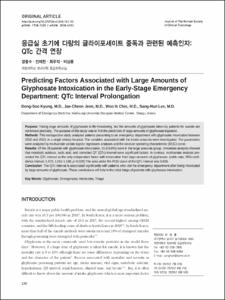KUMEL Repository
1. Journal Papers (연구논문)
1. School of Medicine (의과대학)
Dept. of Emergency Medicine (응급의학)
Predicting Factors Associated with Large Amounts of Glyphosate Intoxication in the Early-Stage Emergency Department: QTc Interval Prolongation
- Keimyung Author(s)
- Jeon, Jae Cheon; Choi, Woo Ik; Lee, Sang Hun
- Department
- Dept. of Emergency Medicine (응급의학)
- Journal Title
- 대한임상독성학회지
- Issued Date
- 2020
- Volume
- 18
- Issue
- 2
- Keyword
- Glyphosate; Emergencies; Herbicides; Triage
- Abstract
- Purpose:
Taking large amounts of glyphosate is life-threatening, but the amounts of glyphosate taken by patients for suicide are not known precisely. The purpose of this study was to find the predictors of large amounts of glyphosate ingestion.
Methods:
This retrospective study analyzed patients presenting to an emergency department with glyphosate intoxication between 2010 and 2019, in a single tertiary hospital. The variables associated with the intake amounts were investigated. The parameters were analyzed by multivariate variate logistic regression analyses and the receiver operating characteristic (ROC) curve.
Results:
Of the 28 patients with glyphosate intoxication, 15 (53.6%) were in the large amounts group. Univariate analysis showed that metabolic acidosis, lactic acid, and corrected QT (QTc) interval were significant factors. In contrast, multivariate analysis presented the QTc interval as the only independent factor with intoxication from large amounts of glyphosate. (odds ratio, 95% confidence interval: 1.073, 1.011-1.139; p=0.020) The area under the ROC curve of the QTc interval was 0.838.
Conclusion:
The QTc interval is associated significantly with patients who visit the emergency department after being intoxicated by large amounts of glyphosate. These conclusions will help in the initial triage of patients with glyphosate intoxication.
- Alternative Title
- 응급실 초기에 다량의 글라이포세이트 중독과 관련된 예측인자: QTc 간격 연장
- Publisher
- School of Medicine (의과대학)
- Citation
- Dong-Soo Kyung et al. (2020). Predicting Factors Associated with Large Amounts of Glyphosate Intoxication in the Early-Stage Emergency Department: QTc Interval Prolongation. 대한임상독성학회지, 18(2), 130–135. doi: 10.22537/jksct.2020.18.2.130
- Type
- Article
- ISSN
- 2508-6332
- Source
- https://ksclintox.jams.or.kr/po/volisse/sjPubsArtiPopView.kci?soceId=INS000007610&artiId=SJ0000000560&sereId=SER000000001&submCnt=1&indexNo=11
- Appears in Collections:
- 1. School of Medicine (의과대학) > Dept. of Emergency Medicine (응급의학)
- 파일 목록
-
-
Download
 oak-2020-0700.pdf
기타 데이터 / 221.91 kB / Adobe PDF
oak-2020-0700.pdf
기타 데이터 / 221.91 kB / Adobe PDF
-
Items in Repository are protected by copyright, with all rights reserved, unless otherwise indicated.